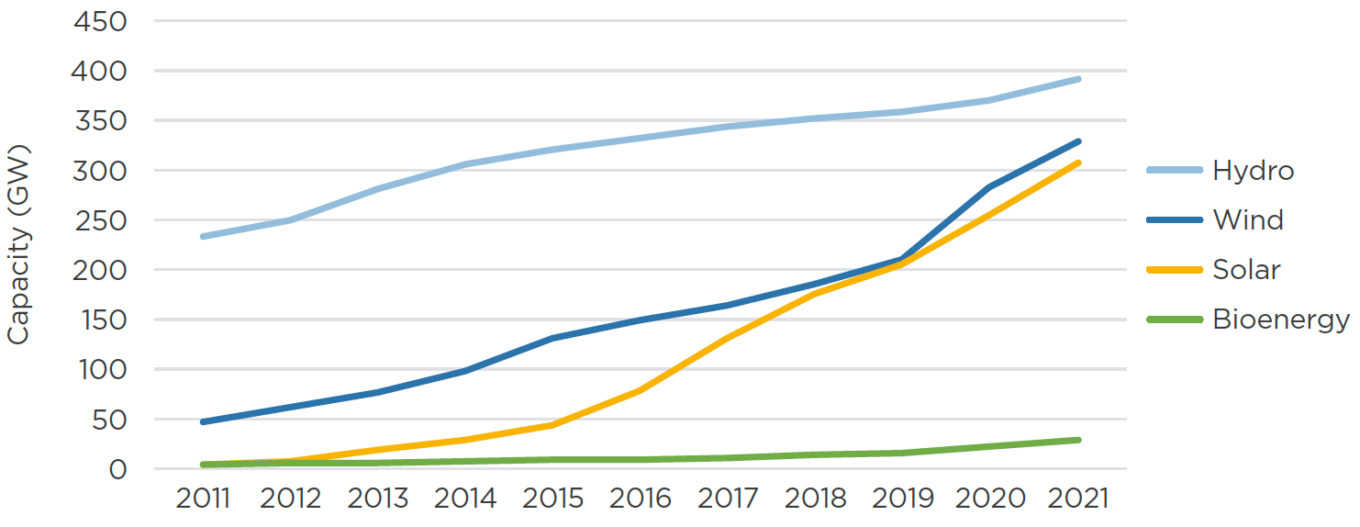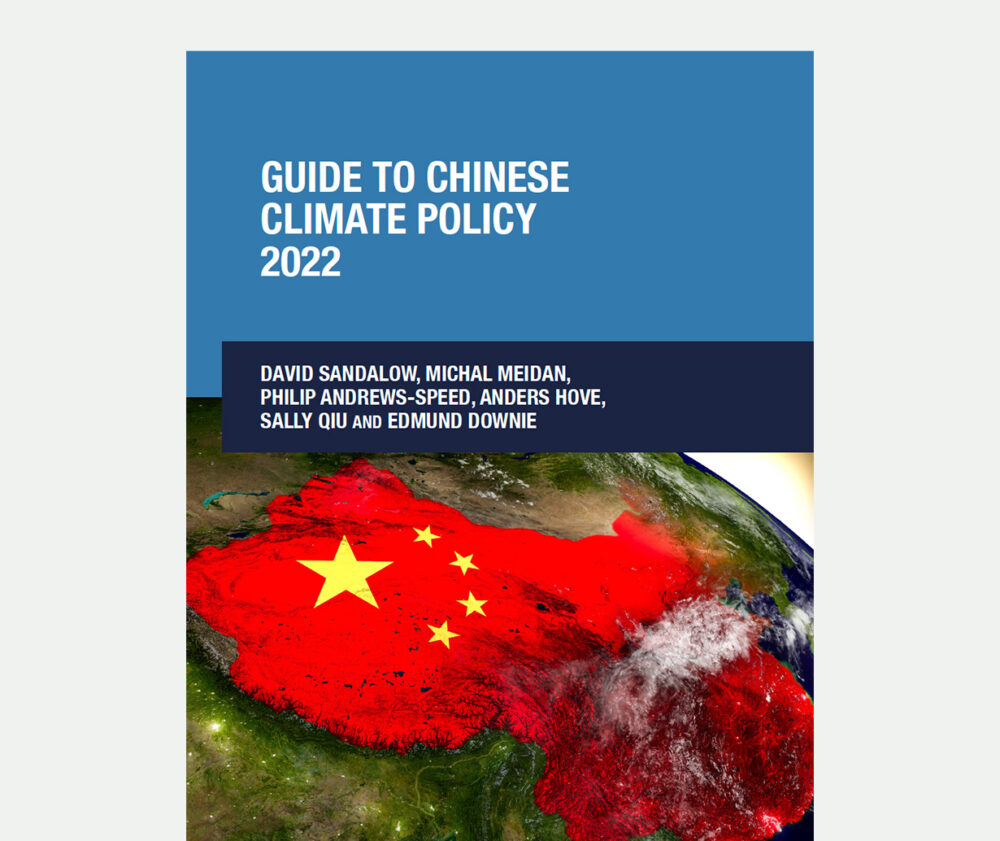China leads the world in deployment of renewable power, with more than three times as much capacity as any other nation. In 2021, 43% of the renewable power capacity added globally was in China. 1 Chinese government’s longstanding commitment to renewable power, as well as China’s enormous population.
On a per capita basis, China’s global rankings with respect to renewable power are generally less high. In 2020, China ranked roughly 30th in the world in renewable energy consumption per capita. 2
Hydropower has been a significant electricity source in China for decades. Wind and solar power have grown dramatically in the past 10 years. In 2021, renewables provided roughly 30% of the electricity generated in China—16% from hydropower, 8% from wind, 4% from solar and 2% from biomass. 3
Figure 6-1: China’s Renewable Power Capacity (2011-2021)

Source: IRENA, Renewable Capacity Statistics 2022 4
This chapter starts with a discussion of cross-cutting renewable power policies (that is, those that apply to more than one type of renewable power). The following sections discuss hydropower, wind power and solar power.
Cross-cutting Renewable Power Policies
The Chinese government’s support for renewable power dates back to at least the 9th Five-Year Plan (1996–2000), which set targets for “new and renewable energy.” 5 In 2005, the Renewable Energy Law set national renewable energy targets, provided financial support and required grid operators to connect to renewable electricity projects. 6
The 13th Five-Year Plan on Renewable Energy, issued by NDRC in December 2016, set targets of 15% non-fossil energy in primary energy consumption, 675 MW of renewable power capacity by 2020, and 20% non-fossil energy in primary energy consumption by 2030. 7 The Plan was implemented with generous feed-in tariffs, access to capital from government policy banks, and other policies and measures. By 2020, the share of non-fossil energy in primary energy consumption in China reached 15.9%, exceeding the target, and renewable power capacity rose to over 930 GW, vastly exceeding the target. 8
Prior to the release of the 14th Five-Year Plan, President Xi Jinping announced China’s commitment to install at least 1,200 GW of wind and solar power capacity, a target that was eventually incorporated into the country’s Nationally Determined Contribution and its Five-Year Plans. 9 China’s focus on establishing remote clean energy bases connected to the cities via large, high-voltage power lines was underlined at the National People’s Congress in 2022, when National Development and Reform Commission (NDRC) Minister He Lifeng said that China would build 450 GW of wind and solar capacity in the Gobi Desert. 10
The 14th Five-Year Plan Outline was released by NDRC in March 2021. The Plan calls for increasing the share of non-fossil energy in primary energy consumption to 20% by 2025 (five years earlier than called for in the 13th Five-Year Plan), changing the wording around wind and solar from “continuing momentum” to “extensive expansion,” building a number of mega-size clean energy bases that integrate different power sources, and expanding pumped hydro storage and other energy storage capacity.
In 2021, China’s State-owned Assets Supervision and Administration Commission of the State Council (SASAC), which manages state-owned enterprises (SOEs), announced a new requirement that central SOE power companies have at least 50% renewable energy capacity by 2025. In 2020, the share of renewable energy capacity at China’s Big Five power generators was under 40%. 11
In March 2022, NDRC issued the 14th Five-Year Plan for a Modern Energy System. In addition to the targets already included in the broader Five-Year Plan, the plan includes a target for the non-fossil share of electricity to rise by 5.8% to 39%, approximately in line with the recent trend. 12
Under the 14th Five-Year Plan for a Modern Energy System, China’s planners will no longer set individual five-year capacity targets for wind, solar, and other new energy sources, but rather emphasize meeting high-level targets for non-fossil energy and removing barriers to clean energy integration. The Plan mentions removing barriers to market trading of distributed energy, including within distribution grids, creating spot markets among multiple provinces (which would help smooth variable renewable energy and thereby resolve integration issues), promoting green power trading by the private sector and emphasizing the construction of hybrid renewable energy bases in tandem with storage. 1>
The Plan lists numerous technologies and applications for continued R&D focus and demonstration, such as agrivoltaics, 14 building-integrated photovoltaics, low-speed wind and deep-water offshore wind. The Plan emphasizes construction of large-scale clean energy bases in remote regions and states that those bases should be connected to high-voltage lines carrying at least 50% renewables. It also calls for eastern provinces to focus on distributed renewables and deploy renewables to enhance energy security, promote technology development and boost green energy employment.15
In June 2022, the National Energy Administration issued the 14th Five-Year Plan for Renewable Energy. The Plan sets targets for non-hydro renewables (wind, solar, biomass and geothermal) to reach an 18% combined share of electricity output in 2025, for all renewables to reach a 33% share and for renewable energy to account for over 50% of incremental energy consumption—implying that coal and other fossil fuels will continue to increase output over the period. The Plan also included five areas that would be targeted for “simultaneous development”: centralized and distributed energy (particularly for solar), onshore and offshore energy, local consumption of renewables and interprovincial transmission, single versus hybrid renewable plants and single versus comprehensive planning of assets. 16
The Chinese government is gradually phasing out feed-in tariffs, which have been central to the Chinese wind and solar industries for the past decade. Starting in 2021, feed-in tariffs were phased out nationally for most PV and onshore wind projects. 17 Feed-in tariffs remain for narrow categories such as offshore wind and concentrating solar power, with the feed-in tariffs for these two categories set and paid for by provincial authorities. 18 Residential rooftops and poverty-alleviation village projects continue to receive national feed-in price premiums, but the budget and quotas available have been cut substantially. 19 In addition, under a policy introduced in 2021, older wind and solar plants receiving feed-in tariffs will have their payments reduced for energy produced beyond a specified number of operating hours per year. 20
Feed-in tariffs are being replaced with a range of policies and market mechanisms, including the following: 21
- auctions in which wind and solar power developers who bid prices less than or equal to the prevailing coal tariff (“grid parity”) will receive contracts that guarantee purchase of all power from their projects at fixed prices for at least 20 years;
- renewable electricity consumption obligations (sometimes compared to renewable portfolio standards in the U.S.) requiring grid companies, large electricity users and others to purchase minimum percentages of renewable electricity set for each province by the National Energy Administration;
- minimum operating hours obligations for each type of renewable energy depending on local conditions;
- green power trading, employing green certificates issued to wind and solar plants; and
- electricity trading via mid- to long-term contracts, and eventually with spot market trading, including via interprovincial markets.
Renewable auctions and renewable consumption quotas were introduced in a series of notices during 2018 and 2019. Under these policies, provinces hold auctions and establish quotas for wind and solar projects. Auction winners receive 20-year power contracts. 22
The main reasons for these changes include the high cost of feed-in tariffs, challenges administering the feed-in tariff program and falling costs for wind and solar power, which will make those technologies increasingly competitive in the years ahead. Most utility-scale wind and solar projects in recent years have been approved via grid parity tenders, which refers to auctions where the tariff is fixed at below the prevailing provincial grid tariff. 23 With the phase-out of national feed-in tariffs, provinces are responsible for determining grid parity project terms and managing any auctions or quotas for such projects. 24
Power sector reforms underway in China could help promote deployment of renewables, as described in detail in Chapter 8 (Power Sector Reform). Historically, most coal plant operators in China received preferential access to the grid through contracts that guaranteed a minimum number of hours of dispatch per year. The power sector reforms underway scale back those guarantees. They also include incentives for interprovincial trading of electricity and pilot programs for dispatching electricity on the basis of the lowest marginal cost, both of which benefit renewables. In November 2021, China’s largest grid company, State Grid, published a new trial policy on cross-provincial power trading that would enable renewable energy to compete in cross-provincial spot markets. 25
In recent years, China has moved towards incorporating energy storage with wind and solar plants, and around half of Chinese provinces have adopted policies requiring or encouraging storage with newly-added utility-scale wind or solar projects. No additional compensation is presently available to meet the extra costs for generation-sited storage. 26
Discussions of the hydro, wind and solar power sectors are below.
References

